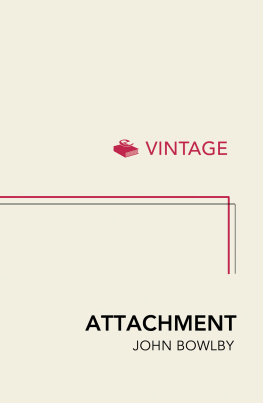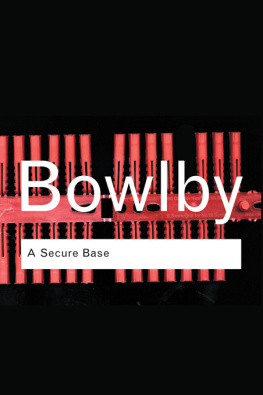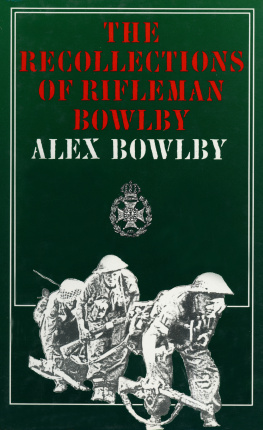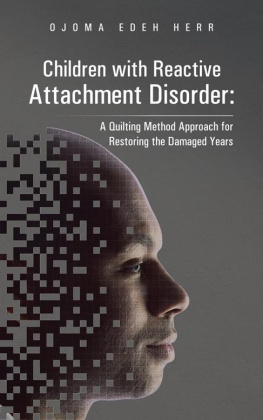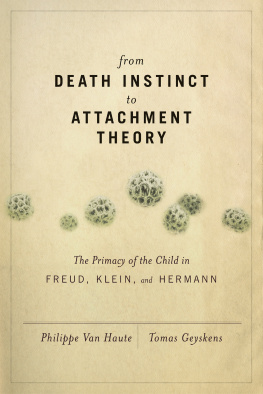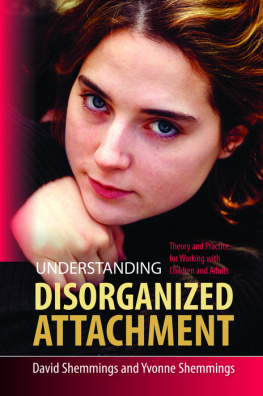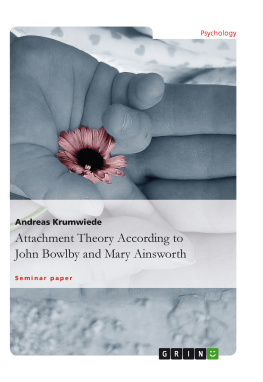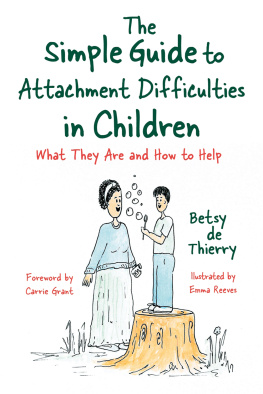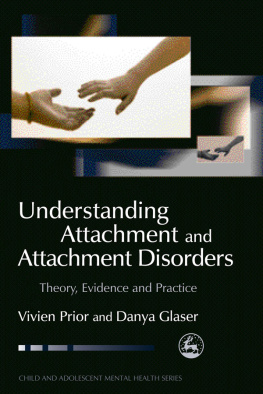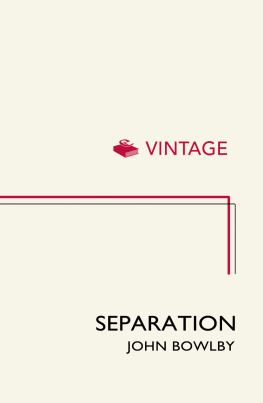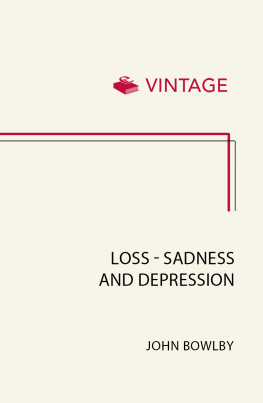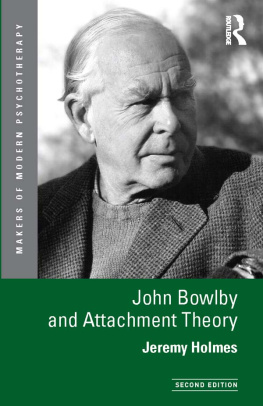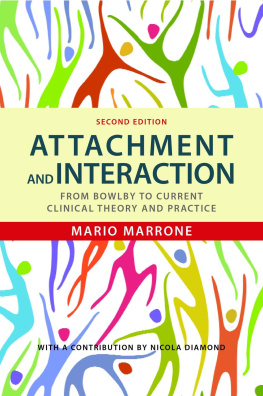Contents
About the Book
In this classic work of psychology John Bowlby examines the processes that take place in attachment and separation and shows how experimental studies of children provide us with a recognizable behaviour pattern which is confirmed by discoveries in the biological sciences. He makes clear that human attachment is an instinctive response to the need for protection against predators, and one as important for survival as nutrition and reproduction.
About the Author
John Bowlby (19071990) was educated at the University of Cambridge and University College Hospital, London. After qualifying in medicine, he specialised in child psychiatry and psychoanalysis. In 1946 he joined the staff of the Tavistock Clinic where his research and influential publications contributed to far-reaching changes in the ways children are treated and to radical new thinking about the social and emotional development of human beings.
He held honorary degrees from the Universities of Cambridge and Leicester and received awards from professional and scientific bodies, including the Royal College of Psychiatrists, the British Paediatric Association, the Society for Research in Child Development, the American Psychological Association and the New York Academy of Medicine.
To
URSULA
Preface
IN 1956 WHEN this work was begun I had no conception of what I was undertaking. At that time my object appeared a limited one, namely, to discuss the theoretical implications of some observations of how young children respond to temporary loss of mother. These observations had been made by my colleague, James Robertson, and together he and I were preparing them for publication. A discussion of their theoretical significance seemed desirable and was destined to form the second part of our book.
Events were to prove otherwise. As my study of theory progressed it was gradually borne in upon me that the field I had set out to plough so lightheartedly was no less than the one that Freud had started tilling sixty years earlier, and that it contained all those same rocky excrescences and thorny entanglements that he had encountered and grappled withlove and hate, anxiety and defence, attachment and loss. What had deceived me was that my furrows had been started from a corner diametrically opposite to the one at which Freud had entered and through which analysts have always followed. From a new viewpoint a familiar landscape can sometimes look very different. Not only had I been deceived in the first place, but subsequently progress has been slow. It has also, I believe, often been difficult for colleagues to understand what I am attempting. It may be of help, therefore, if I put my thinking in a historical perspective.
In 1950 I was asked by the World Health Organisation to advise on the mental health of homeless children. This assignment provided a valuable opportunity to meet with many of the leading workers in the field of child care and child psychiatry and to read the literature. As I wrote in the preface to the resulting report (1951), what struck me amongst those I met was the very high degree of agreement existing in regard to both the principles underlying the mental health of children and the practices by which it may be safeguarded. In the first part of the report I presented evidence and formulated a principle: What is believed to be essential for mental health is that the infant and young child should experience a warm, intimate and continuous relationship with his mother (or permanent mother -substitute) in which both find satisfaction and enjoyment. In the second part I outlined the measures that, in the light of these principles, are necessary if the mental health of children separated from their families is to be safeguarded.
The report proved timely. It helped to focus attention on the problem, contributed to improved methods of care, and stimulated both controversy and research. Yet, as more than one reviewer pointed out, the report had at least one grave limitation. Whereas it had much to say about the many kinds of ill effect that evidence shows can be attributed to maternal deprivation and also about practical measures that may prevent or mitigate these ill effects, it said very little indeed about the processes whereby these ill effects are brought into being. How does it come about that one or another of the events included under the general heading of maternal deprivation produces this or that form of psychiatric disturbance? What are the processes at work? Why should things happen this way? What are the other variables that affect outcome, and how do they affect it? On all these issues the monograph is silent, or nearly so.
The reason for this silence was ignorancemy own and otherswhich could not possibly have been made good in the few months in which the report had to be written. Sooner or later, I hoped, the gap would be filled, though it was unclear when or how.
It was in this frame of mind that I began to give serious attention to observations my colleague James Robertson had been making. With the help of a small grant from the Sir Halley Stewart Trust he had joined me in 1948 to take part in what was intended to be a systematic inquiry into the whole problem of the effects on personality development of separation from mother in early childhood. During an extended reconnaissance of what was at that time largely virgin ground he had observed a number of young children before, during, and after a stay away from home; most of these children were in their second and third years of life and not only were separated from their mothers but for periods of weeks or months were cared for in settings, such as hospital or residential nursery, in which they had no stable mother-substitute. During this work he had been deeply impressed by the intensity of the distress and misery he was witness to whilst the children were away from home and by the extent and duration of the disturbance that was present after they had returned there. No one reading his written reports or viewing the film record he made of one little girl could be left unmoved . Nevertheless, at that time there was no agreement about the significance or relevance of these observations. Some challenged their validity; others recognised that the responses occurred but attributed them to almost anything but loss of mother-figure; yet others conceded that loss was a relevant variable but held that to mitigate its effects was not too difficult and that loss was therefore of less consequence for pathology than we supposed.
My colleagues and I took a different view. We were confident that the observations were valid; all the evidence pointed to loss of mother-figure as a dominant variable, though not the only one; and our experience suggested that, even when other circumstances were favourable, there was more distress and disturbance than was usually recognised. Indeed, we held the view that the responses of protest, despair, and detachment that typically occur when a young child aged over six months is separated from his mother and in the care of strangers are due mainly to loss of maternal care at this highly dependent, highly vulnerable stage of development. From empirical observation we suggested that the young childs hunger for his mothers love and presence is as great as his hunger for food, and that in consequence her absence inevitably generates a powerful sense of loss and anger. We were concerned particularly with the great changes in a childs relation to his mother that are often to be seen when he returns home after a period away; on the one hand, an intense clinging to the mother which can continue for weeks, months or years; on the other, a rejection of the mother as a love object, which may be temporary or permanent. The latter state, to which we later came to refer as detachment, we held to be a result of the childs feelings for his mother having undergone repression.
Next page
